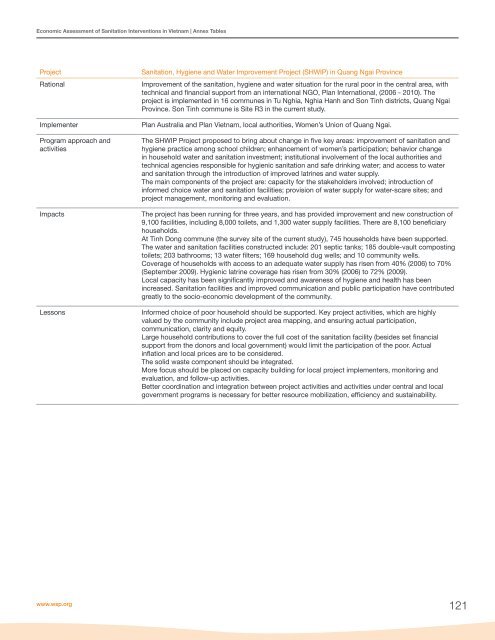Economic Assessment of Sanitation Interventions in Vietnam - WSP
Economic Assessment of Sanitation Interventions in Vietnam - WSP
Economic Assessment of Sanitation Interventions in Vietnam - WSP
You also want an ePaper? Increase the reach of your titles
YUMPU automatically turns print PDFs into web optimized ePapers that Google loves.
<strong>Economic</strong> <strong>Assessment</strong> <strong>of</strong> <strong>Sanitation</strong> <strong>Interventions</strong> <strong>in</strong> <strong>Vietnam</strong> | Annex TablesProjectRationalImplementerProgram approach andactivitiesImpactsLessons<strong>Sanitation</strong>, Hygiene and Water Improvement Project (SHWIP) <strong>in</strong> Quang Ngai Prov<strong>in</strong>ceImprovement <strong>of</strong> the sanitation, hygiene and water situation for the rural poor <strong>in</strong> the central area, withtechnical and f<strong>in</strong>ancial support from an <strong>in</strong>ternational NGO, Plan International, (2006 - 2010). Theproject is implemented <strong>in</strong> 16 communes <strong>in</strong> Tu Nghia, Nghia Hanh and Son T<strong>in</strong>h districts, Quang NgaiProv<strong>in</strong>ce. Son T<strong>in</strong>h commune is Site R3 <strong>in</strong> the current study.Plan Australia and Plan <strong>Vietnam</strong>, local authorities, Women’s Union <strong>of</strong> Quang Ngai.The SHWIP Project proposed to br<strong>in</strong>g about change <strong>in</strong> five key areas: improvement <strong>of</strong> sanitation andhygiene practice among school children; enhancement <strong>of</strong> women’s participation; behavior change<strong>in</strong> household water and sanitation <strong>in</strong>vestment; <strong>in</strong>stitutional <strong>in</strong>volvement <strong>of</strong> the local authorities andtechnical agencies responsible for hygienic sanitation and safe dr<strong>in</strong>k<strong>in</strong>g water; and access to waterand sanitation through the <strong>in</strong>troduction <strong>of</strong> improved latr<strong>in</strong>es and water supply.The ma<strong>in</strong> components <strong>of</strong> the project are: capacity for the stakeholders <strong>in</strong>volved; <strong>in</strong>troduction <strong>of</strong><strong>in</strong>formed choice water and sanitation facilities; provision <strong>of</strong> water supply for water-scare sites; andproject management, monitor<strong>in</strong>g and evaluation.The project has been runn<strong>in</strong>g for three years, and has provided improvement and new construction <strong>of</strong>9,100 facilities, <strong>in</strong>clud<strong>in</strong>g 8,000 toilets, and 1,300 water supply facilities. There are 8,100 beneficiaryhouseholds.At T<strong>in</strong>h Dong commune (the survey site <strong>of</strong> the current study), 745 households have been supported.The water and sanitation facilities constructed <strong>in</strong>clude: 201 septic tanks; 185 double-vault compost<strong>in</strong>gtoilets; 203 bathrooms; 13 water filters; 169 household dug wells; and 10 community wells.Coverage <strong>of</strong> households with access to an adequate water supply has risen from 40% (2006) to 70%(September 2009). Hygienic latr<strong>in</strong>e coverage has risen from 30% (2006) to 72% (2009).Local capacity has been significantly improved and awareness <strong>of</strong> hygiene and health has been<strong>in</strong>creased. <strong>Sanitation</strong> facilities and improved communication and public participation have contributedgreatly to the socio-economic development <strong>of</strong> the community.Informed choice <strong>of</strong> poor household should be supported. Key project activities, which are highlyvalued by the community <strong>in</strong>clude project area mapp<strong>in</strong>g, and ensur<strong>in</strong>g actual participation,communication, clarity and equity.Large household contributions to cover the full cost <strong>of</strong> the sanitation facility (besides set f<strong>in</strong>ancialsupport from the donors and local government) would limit the participation <strong>of</strong> the poor. Actual<strong>in</strong>flation and local prices are to be considered.The solid waste component should be <strong>in</strong>tegrated.More focus should be placed on capacity build<strong>in</strong>g for local project implementers, monitor<strong>in</strong>g andevaluation, and follow-up activities.Better coord<strong>in</strong>ation and <strong>in</strong>tegration between project activities and activities under central and localgovernment programs is necessary for better resource mobilization, efficiency and susta<strong>in</strong>ability.www.wsp.org121
















